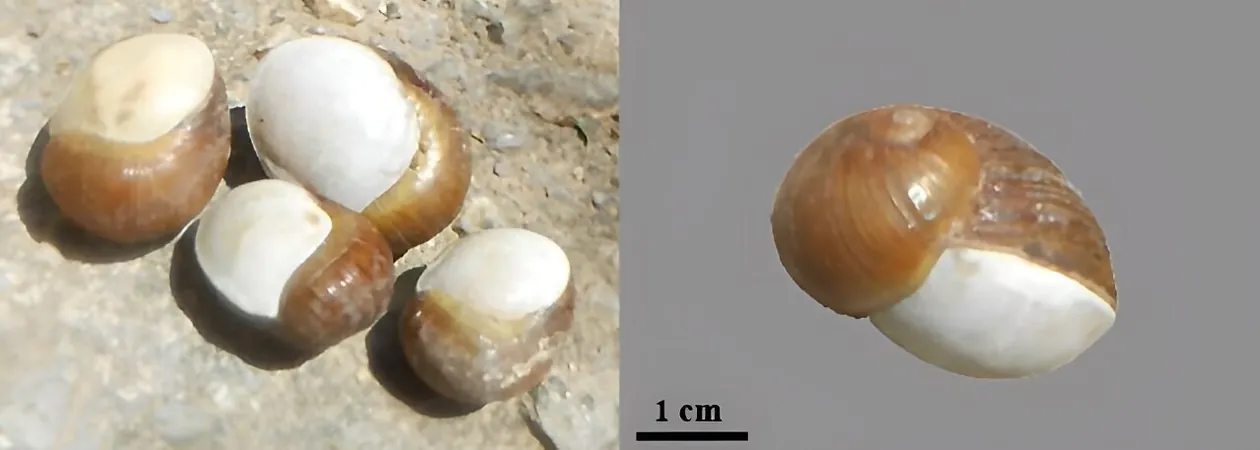
Unlocking the Mysteries of Ancient Culinary Traditions: Tunisian Snail Remains Date Back 7700 Years!
2024-10-08
Author: John Tan
A groundbreaking study led by Dr. Ismail Saafi from Aix-Marseille Université has unveiled remarkable insights into the ancient culinary practices of Tunisia, revealing the consumption of snails dating back approximately 7710 years.
This discovery, made at the Kef Ezzahi site in northern Tunisia, holds the distinction of being the only known case of intact snail epiphragms found in northern Africa, showcasing a unique facet of prehistoric diets.
Study Findings
The study, published in Archaeological and Anthropological Sciences, provides a deeper understanding of how ancient Tunisian societies may have incorporated snails into their diets.
The Kef Ezzahi site is one of the rare locations known to contain rammadiyet—massive accumulations of shell remains.
Excavations in 2012 uncovered over 35,000 shells from the species Sphincterochila candidissima, with 41 remains showing intact epiphragms, a temporary closing membrane snails produce during unfavorable climatic conditions.
Importance of Epiphragms
Dr. Saafi elaborates on the function of epiphragms, explaining that they serve to protect snails from water loss during extreme temperatures or drought conditions.
This astonishing find not only raises intriguing questions about dietary habits but also suggests that traditional snail consumption may have roots going back thousands of years.
Comparative Analysis
Interestingly, comparisons with other archaeological finds, such as those in Turkey, indicate that while some snail shells with epiphragms have been discovered, they often show signs of predation rather than human collection for consumption.
The discovery at Kef Ezzahi is, therefore, groundbreaking as it represents the oldest evidence of humans deliberately collecting land snails specifically for culinary purposes.
Modern Ethnographic Study
To further uncover why snails with epiphragms are so rare in archaeological records, Dr. Saafi conducted an ethnographic study among modern populations in Aouled Said.
This modern group primarily collects Cantareus apertus, another snail species capable of producing epiphragms.
Their collection practices reveal a meticulous approach, with families targeting specific snail sizes based on taste with a harvesting season aligned with summer, from April to July.
Labor-Intensive Process
Collecting snails involves significant labor, including the use of pickaxes to unearth them from the ground.
Once harvested, snails must be stored carefully in ash or sawdust to preserve their epiphragms.
Collectors avoid snails that lack epiphragms, as they are viewed as unsanitary, highlighting a continuity of cultural practices relating to food purity that may date back to prehistoric times.
Sustainable Collection Practices
On average, collectors can harvest around 1 kg of snails in a day, leaving juveniles behind to ensure future populations remain sustainable.
The challenges of this labor-intensive process mean that snail collection tends to be carried out by men or older youths, with knowledge of techniques passed down through generations.
Conclusion
Dr. Saafi suggests that the relative scarcity of epiphragms in other archaeological contexts is not merely a result of preservation bias but rather linked to the demands of obtaining them.
The seasonal and skill-intensive nature of gathering these snails makes them less appealing compared to other, more easily harvested species.
This discovery sheds light on the ancient culinary practices in Tunisia, indicating that prehistoric groups may have specialized in the collection of S. candidissima, just as contemporary communities do.
The findings not only reveal the importance of snails in ancient diets but also potentially offer insights into the cultural continuity in Tunisia's food traditions.
As we continue to explore our ancient past, these discoveries help paint a picture of resilient culinary practices that have persisted through time, allowing us to appreciate the rich tapestry of human history that connects us to our ancestors.
Stay tuned for further developments in this fascinating field of research that links archaeology, anthropology, and gastronomy!

 Brasil (PT)
Brasil (PT)
 Canada (EN)
Canada (EN)
 Chile (ES)
Chile (ES)
 España (ES)
España (ES)
 France (FR)
France (FR)
 Hong Kong (EN)
Hong Kong (EN)
 Italia (IT)
Italia (IT)
 日本 (JA)
日本 (JA)
 Magyarország (HU)
Magyarország (HU)
 Norge (NO)
Norge (NO)
 Polska (PL)
Polska (PL)
 Schweiz (DE)
Schweiz (DE)
 Singapore (EN)
Singapore (EN)
 Sverige (SV)
Sverige (SV)
 Suomi (FI)
Suomi (FI)
 Türkiye (TR)
Türkiye (TR)